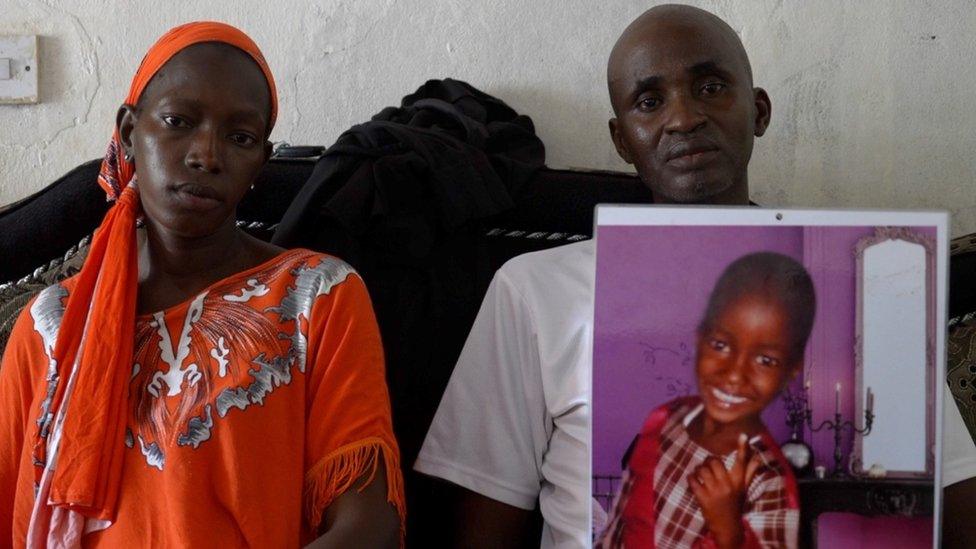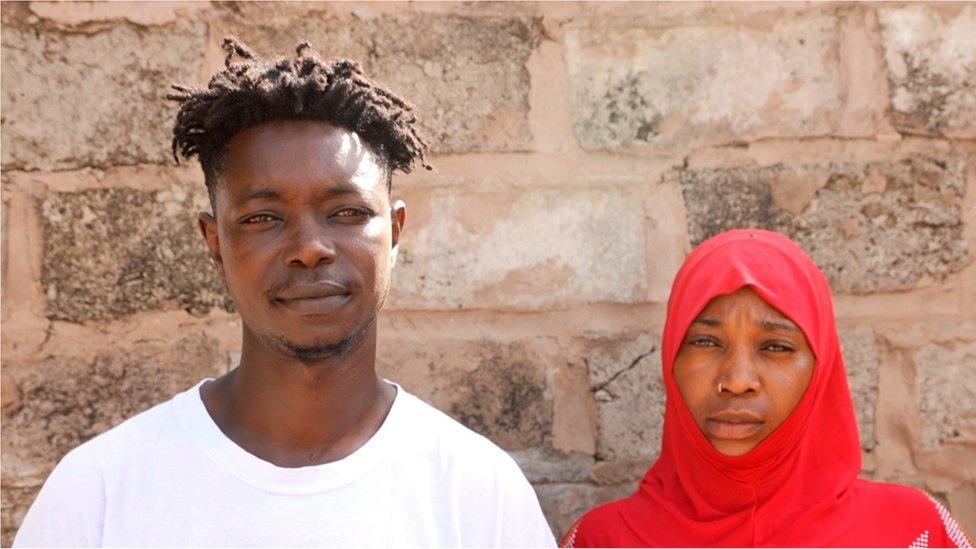Maiden Pharmaceuticals: Fury in The Gambia over India cough syrup deaths
- Published

Ebrima Sajnia and his wife watched their son die last year
In September last year, Ebrima Sajnia watched helplessly as his young son slowly died in front of his eyes.
Mr Sajnia, who works as a taxi driver in The Gambia, says three-year-old Lamin was set to start attending nursery school in a few weeks when he got a fever. A doctor at a local clinic prescribed medicines, including a cough syrup, but the feverish child refused to take them.
"I forced Lamin to drink the syrup," recalls Mr Sajnia, sitting at his home in Banjul, capital of The Gambia.
Over the next few days, Lamin's condition deteriorated as he struggled to eat and even urinate. He was admitted to a hospital, where doctors detected kidney issues. Within seven days, Lamin was dead.
He was among around 70 children - younger than five - who died in The Gambia of acute kidney injuries between July and October last year after consuming one of four cough syrups made by an Indian company called Maiden Pharmaceuticals.
In October, the World Health Organization (WHO) linked the deaths to the syrups, saying it had found "unacceptable" levels of toxins in the medicines.
A Gambian parliamentary panel also concluded after investigations that the deaths were the result of the children ingesting the syrups.
Both Maiden Pharmaceuticals and the Indian government have denied this - India said in December that the syrups complied with quality standards when tested domestically.
It's an assessment that Amadou Camara, chairperson of the Gambian panel that investigated the deaths, strongly disagrees with.
"We have evidence. We tested these drugs. [They] contained unacceptable amounts of ethylene glycol and diethylene glycol, and these were directly imported from India, manufactured by Maiden," he says. Ethylene glycol and diethylene glycol are toxic to humans and could be fatal if consumed.

The deaths shocked people in The Gambia, which imports most of its medicines from India
It's a difficult situation for The Gambia, one of Africa's smallest countries, which imports most of its medicines from India. Some bereaved parents say they don't trust Indian-made drugs anymore.
"When I read that a medicine is from India, I barely touch it," said Lamin Danso, who lost his nine-month-old son.
But the reliance on Indian drugs is unlikely to change anytime soon.
"Most pharmacists are still bringing in drugs from India - it's far cheaper than importing drugs from America or Europe," says journalist Mustapha Darboe.
India is the world's largest exporter of generic drugs, meeting much of the medical needs of developing countries. But allegations that its drugs have caused tragedies like the one in The Gambia - and in other countries such as Uzbekistan and the US - have raised questions about manufacturing practices and quality standards.
"If you see the tragedy, and the kind of alerts declared by WHO, so many countries are thinking twice. They are regularly enquiring. It's not very comfortable. I call it an aberration. It's a costly aberration," says Udaya Bhaskar, director general of the Pharmaceuticals Export Promotion Council of India.
He says while incidents like the one in The Gambia and Uzbekistan have "made a dent" on the Indian pharmaceutical industry's image, it hasn't impacted exports.
India exported medicines worth $25.4bn (£20bn) in the financial year ending in March 2023 - of these, $3.6bn was to countries in Africa. Mr Bhaskar points out that the country has already exported drugs worth more than $6bn in the first quarter of the current financial year.
But India has announced steps such as making it compulsory for companies to get cough syrup samples tested at government-approved laboratories before exporting. The Gambia, which does not have drug testing laboratories, has also made this mandatory, external for medicines exported from India since July.
India has also set deadlines for its pharma companies to adopt WHO-standard good manufacturing practices.

Some of the families have filed a case in the Gambian high court
But some Indian activists allege that the country has had a "two-tier manufacturing system" for a long time.
"What we export to the US and Europe, we try and use much more stringent standards compared to drugs made for local consumption and exported to less regulated markets," alleges Dinesh Thakur, a public health activist.
Mr Bhaskar disagrees, saying that several countries in Africa - India's third-largest export destination - have "robust" regulatory mechanisms.
A recent Gambian government report on the tragedy has recommended the establishment of a quality control laboratory and two drug regulators have been dismissed.
"We know the anger in the society. We know the anger among the victims," says Billay G Tunkara, the majority leader of the Gambian National Assembly and head of government business.
But devastated parents say nothing has changed in the country's health sector over the past year - the medical system struggled to cope with the influx of fever cases and some parents were forced to raise funds to send their children to neighbouring Senegal.
Momodou Dambelleh, who sells wood for a living, was one of them. He last saw Aminata, his 22-month-old daughter, on a video call as she lay unresponsive on a hospital bed.
"I could only see her head moving. I was trying to let her know it was me, her papa," he says. That was shortly before she died.
"Those who committed the crime, including the health minister, should face the full force of the law," says Ebrima EF Saidy, spokesperson for a group representing the parents of the victims.
Dr Ahmadou Lamin Samateh, health minister of the Gambia, did not respond to the BBC's request for an interview.

Momodou Dambelleh and his wife sent their daughter to neighbouring Senegal for treatment
A year on, many of the parents say they are determined to make sure that others in The Gambia don't have to experience such pain again.
The families of 19 children have sued local health officials and Maiden Pharmaceuticals in the Gambian high court. They say they won't hesitate to approach Indian and international courts as well if needed.
"The government's negligence made the children die," says Mr Sagnia, who is part of the group.
This is the first in a two-part series.
BBC News India is now on YouTube. Click here, external to subscribe and watch our documentaries, explainers and features.

Read more India stories from the BBC:
